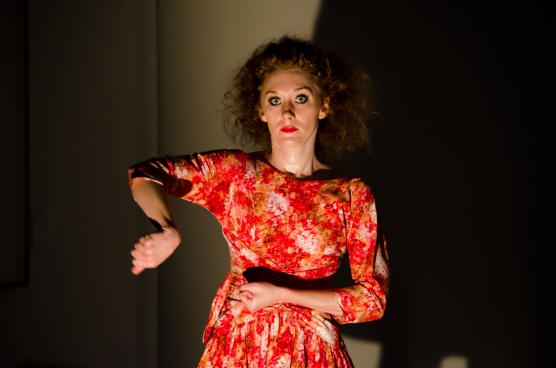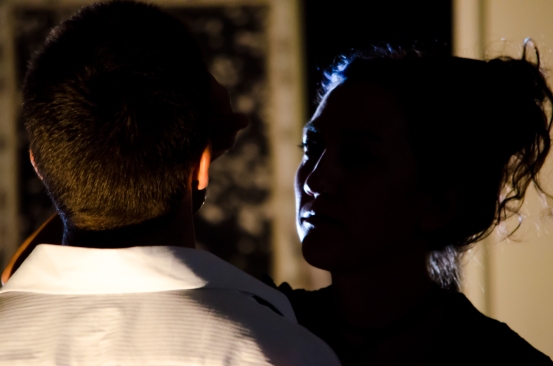A woman a man a woman their shadows cast against the wall a shadow play what is this she tells him faces him but I can’t hear I can’t hear can anyone hear what is it I can’t hear her and he turns from us so we can’t see his face. Is this what I think it is, this separation?
They dip dip in time is it work a factory line are they making something is it preparation sustenance exercise manufacturing is she at a sink a conveyor belt a bench she gazes out to us as if through a window and she must see us we are so close and I see us some of us in her eyes her wide wide open eyes I don’t know what to do I want the woman and man to stop to be still but if we are all still and they are still what will there be? And the woman on the side sitting on a stool facing the audience is she excluded do I do we presume this? I worry for them oh I worry at so much work how it continues. Dip squat stir place back and up again down.
An audience might be happiest on the other side as that is where they know how to be but some join in as I did I did last time not knowing what to do now one blows their breath on the sweaty skin at the nape of her neck and then her forehead another brings her a glass of water but she gestures he should hold the glass for her to drink so there must be rules are they made in the moment or before for us to find what can happen what has been decided what is possible here?
The child can disrupt her touch stops the working woman engages her response as there is no acting I believe here compassion in these moments for being and others want like I resolution being apart and then together again but this is is connection and a look is possible between the man and woman but not more any more not a touch only mirroring they stay apart face away only shadows touching the audience a bridge sometimes.
A woman from the audience danced with the man and they swayed together, I could see her smile and his possibly his smile reflected back to us through hers another made herself into a chair on hands and knees so he could sit with his back to us this balance held for a moment. One of the audience pleaded and we could hear what they said they seemed strange these words to me did they to others our words our want for their stillness our pleading and distress foreign and if they stopped if they stopped dipping working making even if it seems without meaning what could there be anymore? Voice in drum and wind shifting dipping with them working marrying us in space and song and violin holding us threading us, the still woman’s voice singing here I am here here I am …  Last time I stepped forward step after step and held the working woman opening my arms to see if I could and she stepped within them and I patted patted her back she was burning burning hot she and her heart beat beat beat fast in me fast and we swayed she like my child as her heart beat slowed slowed the drama of uncertainty for me which is only mine it was her heart I felt in this and that I did not know her and I could still her her heart if she wanted was allowed to quiet to a resting beat and share relief it returned just then before I hesitated hesitant in how to leave.
Last time I stepped forward step after step and held the working woman opening my arms to see if I could and she stepped within them and I patted patted her back she was burning burning hot she and her heart beat beat beat fast in me fast and we swayed she like my child as her heart beat slowed slowed the drama of uncertainty for me which is only mine it was her heart I felt in this and that I did not know her and I could still her her heart if she wanted was allowed to quiet to a resting beat and share relief it returned just then before I hesitated hesitant in how to leave.
I attended two performances of Little Dove Theatre Art’s ‘From This’ at the Canberra Museum and Gallery in association with their Pulse: Reflections on the Body exhibition. Very moved by the first performance, I was determined to return for the next one, and bring my family. Dylan Jones took the photos in this post. We were part of the rhizome of the audience, shadowy, close, subterranean, sprouting and blooming and connecting unexpectedly. I look forward to seeing or hearing how this project continues to develop and to Chenoah Miller‘s ‘Evangeline’ on soon in Canberra as part of Art Not Apart.















